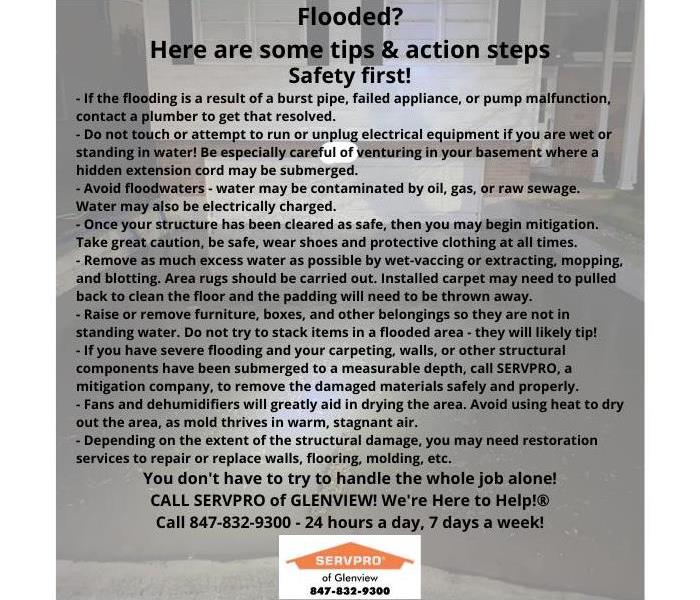Flooded? Follow these safety tips!
6/4/2020 (Permalink)
 At some point in your life, you may experience a flood in your home, whether large or small. Here are some safety tips and action steps to follow.
At some point in your life, you may experience a flood in your home, whether large or small. Here are some safety tips and action steps to follow.
Flooded???
Whether your home is a single-residence house, a townhome, a condo, an apartment, or even a cabin, dealing with a flood should follow a similar timeline.
First and foremost: YOUR SAFETY! Account that all family members or residents (including pets) are safe! If this is a major flood event, you may have to evacuate your residence. If water enters the building making evacuation impossible, move to an upper floor or higher area and wait for rescuers.
A note on driving safety: If you evacuated, do not attempt to drive through floods or rising waters! Nearly half of all flash flood fatalities are auto-related.
A flood in your home can occur for many reasons. Storm damage is a big reason: a storm, a flash flood, backed up sewers or storm drains, storm damage to the home that allows water indoors (such as a hole in the roof or a broken window). Storm damage can wreak havoc on your home, bringing in as little as an inch, or worse - water measured in feet.
Water damage can also occur due to something inside the home failing:
- a burst pipe (whether it was frozen or not)
- a failed hose, valve, or coupling
- an appliance malfunction (such as a broken dishwasher, washing machine, water heater, or refrigerator)
- a pump that failed to function properly (whether it's a sump pump or an ejector pump)
- an overflowing toilet or a "stuck" faucet that caused a sink, tub, or shower to overflow
Obviously, water and storm damage caused by nature is out of your control. You can only wait it out. Only once the storm is over and the flood waters have begun to recede can you begin to take stock of the damage and begin the mitigation and reconstruction processes.
However, when you have an event that is not of natural causes, such as that occurs when pipes burst or appliances fail, it is imperative to stop the water at the source. You may need to turn off the water supply, either to a specific appliance or area or to the whole home, by turning off the water shutoff valve. Once the water has been stopped, you need to take steps to fix the problem. Likely your first call will be to a plumber.
Once the source of the water has been addressed, you can then assess the damage. If you were present at the time of the water damage, perhaps you were able to prevent the water from soaking your furniture and belongings by moving them to drier areas. But if the water damaged structural components of your home - flooring, walls, molding/trim, stairs, doors - as well as your belongings, then the mitigation ahead is much larger, and perhaps beyond your abilities to handle.
When in doubt, call in the professionals! Support your local SERVPRO! We are Here to Help® 24/7/365. SERVPRO teams are Fire & Water - Cleanup & Restoration™ experts!
If you are in the near North and Northwest suburbs of Chicago, the crews of SERVPRO of Glenview may be your nearest mitigation specialists! Call us when you need us and we'll be there to help make it Like It Never Even Happened.
Call 847-832-9300 to speak to a SERVPRO of Glenview team member about your emergency water damage needs.
In the meantime, if you should find yourself dealing with a flood in your home, try to remember these safety tips and action steps.





 24/7 Emergency Service
24/7 Emergency Service